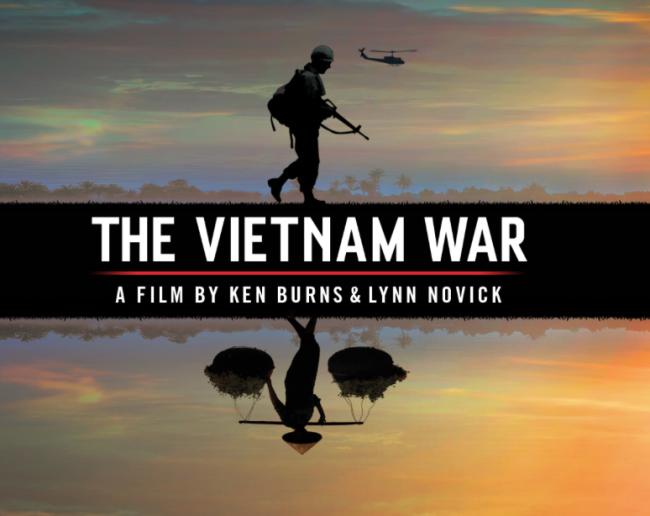You have /5 articles left.
Sign up for a free account or log in.

PBS
WASHINGTON -- Ken Burns and Lynn Novick’s recent 18-hour PBS documentary on the Vietnam War was adored by critics (The New York Times, for example, said it would “break your heart and win your mind”). And judging by the numbers -- some 34 million viewers total -- audiences loved it, too.
But historians? Not so much, based on a lively weekend panel called “A Fateful Misunderstanding: A Discussion of the Film Documentary The Vietnam War” during the annual meeting of the American Historical Association.
One big problem, panelists said, was Burns and Novick’s deliberate exclusion of professional historians from their 80 talking heads. By the panelists’ accounting, the documentary included two trained historians with military credentials but otherwise relied on witnesses -- mainly U.S. veterans and their families.
The panelists, all academic historians, credited Burns and Novick with including some North Vietnamese veterans but questioned any attempt to tell the full story of the Vietnam War without an explicit critical interpretation. Such a perspective, or perspectives, are crucial in the name of history, they said, and also in terms of how history can inform the political present -- namely one that also involves long-term military engagement with shifting objectives.
In various press interviews, Burns has drawn many parallels between the Vietnam era and the present. But the documentary itself avoids overt judgments about policy decisions that led to and prolonged the war, and instead takes what panelists described as an “elegiac” and “conciliatory” tone.
“I have number of very serious criticisms of this film, but I’ve talked to a number of friends outside of academic life who will say something to this effect: ‘Yeah, it wasn’t critical enough for you, but there was a great soundtrack, incredible archival footage, really a lot of history and I didn’t know any of this stuff,’” said Christian G. Appy, a professor of history at the University of Massachusetts at Amherst. Saying many of his nonacademic friends had argued that the documentary -- while perhaps incomplete -- is “better than nothing,” Appy posed the question to the room.
Appy also asked if it was inevitable that public history projects in general -- which are often expensive and by definition seek broad audience appeal -- will carve out a “centrist position and pull critical punches and leave out more extreme points of view.”
As for the latter question, Appy said yes, it was probably true. But the role of historians and scholars in such discussions is "not to capitulate to the public history problem of tending to prize commemoration over criticism.” Instead, he said, they should “push on relentlessly, trying to nudge the needle a little bit, so that more critical perspectives are included in museum exhibits and other public history projects.”
Mark Philip Bradley, the Bernadotte E. Schmitt Distinguished Service Professor of International History and the College at the University of Chicago, said he’d always been curiously immune to the Ken Burns “magic,” in that Burns’s previous works on the Civil War and other topics seemed painfully long. So Bradley said he was pleasantly surprised that Burns and Novick so powerfully portrayed individual Vietnam veterans’ stories.
Yet their glossing over of previous U.S. military involvement in Asia and overall framing of the war as a “tragedy” rather than a series of “immeasurable and irredeemable” mistakes makes the documentary fall flat, he said. For the war to be fully understood, "we need other kinds of stories, too.”
Carolyn Eisenberg, a professor of history at Hofstra University, said the Vietnam documentary reminded her of many undergraduates’ comments upon reading their first historical monograph: they often complain that an author has “too many opinions” and should focus on “the facts,” as if their high school textbooks had no bias whatsoever.
On its face, she said, the Burns and Novick documentary is similarly misleading, in that it seems to communicate there is "no truth in war." She quoted from the introduction the filmmakers wrote for a book based on their series (echoed by the film's narrator), which says, in part, “We did not set out to answer every question embedded in this lamentable chapter in history. With open minds and open hearts we simply tried to listen to the brave and honest testimony of a remarkable group of men and women.”
In reality, Eisenberg said, Burns and Novick made two major interpretive decisions: making footage of battle after battle a centerpiece of the film and omitting “any focus” on policy making. For example, she said, the film alluded to the Cold War and containment as the initial rationale for involvement in Vietnam. Yet it didn’t point out that President Nixon’s cordial visit to Communist China during the war seemingly reversed that “core logic,” she said.
Eisenberg, who participated in many protests against the conflict, said the film also failed to clearly demonstrate that antiwar activists opposed not only war but the deaths of so many young U.S. men. Moreover, she said, Burns and Novick didn’t sufficiently credit these “grassroots” protesters with bringing the war to its eventual end.
Heather Marie Stur, an associate professor of history at the University of Southern Mississippi, questioned the documentary’s lack of representation of contemporaneous South Vietnamese voices, saying Burns and Novick apparently took for granted the “political vibrancy and diversity” of Saigon at the time. While younger South Vietnamese citizens and Roman Catholics were early supporters of the war, for example, she said, many grew to oppose it over time due to general fatigue, concerns about government corruption and the influence of liberation theology.
It wasn’t just "a pawn,” Stur said of South Vietnam. “And trying to understand some of those perspectives might help us understand U.S. policy mistakes,” perhaps even when it comes to North and South Korea today.
Many audience members agreed with the panelists, highlighting gaps they perceived in Burns and Novick’s narratives: women and foreign service officers, for example. But some asked if a nuanced, critical piece would have had the same reach -- or any broad appeal at all.
Panel moderator Michael Kazin, professor of history at Georgetown University, said he shared some of his colleagues' criticisms. But he said he was also at times moved to tears by the documentary, including footage he hadn't seen in years of veterans throwing their service medals and ribbons at the U.S. Capitol and of the massacre at My Lai.
"Can a popular documentary that is intended to inform a wide range of Americans about the war and how different Americans saw the war at the time do what a critical history book can do?" he asked. Could a documentarian “make both films at the same time," one that is critical and moves a broad range of Americans?
Bradley’s answer was simple: “If it’s engaging, yes.”





